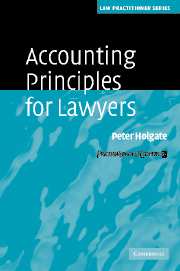Book contents
- Frontmatter
- Contents
- Acknowledgements
- Glossary of terms
- Part I The accounting environment
- Part II Some specifics
- 8 Individual entity accounts and consolidated accounts
- 9 Mergers and acquisitions
- 10 Interaction of accounting with tax
- 11 Assets
- 12 Liabilities
- 13 Leases
- 14 Pensions
- 15 Financial instruments, including capital instruments
- 16 Realised and distributable profits
- 17 Disclosures in published accounts
- 18 Use of financial information in contracts and agreements
- Appendices
- Index
8 - Individual entity accounts and consolidated accounts
from Part II - Some specifics
Published online by Cambridge University Press: 28 July 2009
- Frontmatter
- Contents
- Acknowledgements
- Glossary of terms
- Part I The accounting environment
- Part II Some specifics
- 8 Individual entity accounts and consolidated accounts
- 9 Mergers and acquisitions
- 10 Interaction of accounting with tax
- 11 Assets
- 12 Liabilities
- 13 Leases
- 14 Pensions
- 15 Financial instruments, including capital instruments
- 16 Realised and distributable profits
- 17 Disclosures in published accounts
- 18 Use of financial information in contracts and agreements
- Appendices
- Index
Summary
The distinction between entity accounts and consolidated accounts
General distinction
There is an important distinction between the accounts of an individual entity, such as a company, and the consolidated accounts of a group. An individual entity could take a number of forms. The most common example is a single company, but an entity for accounting purposes could be a partnership or joint venture – that is, it does not need to have separate legal personality. A group typically comprises a parent company and a number of subsidiary undertakings.
Entity accounts, sometimes called ‘individual’, or ‘solus’ accounts, are the accounts of the entity itself. Thus, where a company transacts much of its business through subsidiaries rather than directly itself, its entity accounts will record an investment in one or more subsidiaries in its balance sheet and will record dividend income in its profit and loss account. The trading transactions will be included in the individual entity accounts of the subsidiaries themselves and are not reflected in the parent's individual entity accounts.
It is generally accepted that the individual accounts of a parent entity, while they have some uses, do not properly reflect the parent's results, assets and liabilities. For example, where much of the business is carried out in one or more of the parent's subsidiaries, this would not be reflected in the entity accounts of the parent. Hence, for many years, it has been the practice to prepare ‘group accounts’ for groups of companies, albeit with exceptions as discussed below.
- Type
- Chapter
- Information
- Accounting Principles for Lawyers , pp. 77 - 90Publisher: Cambridge University PressPrint publication year: 2006



